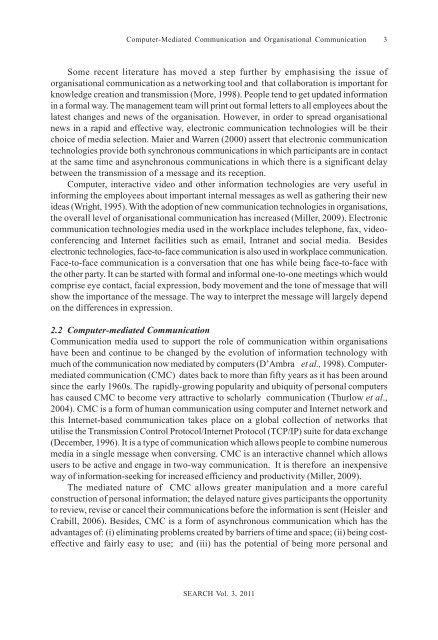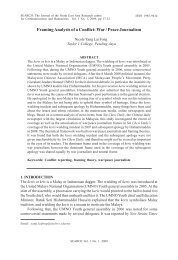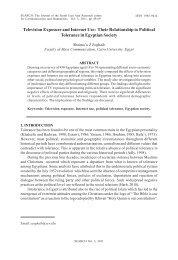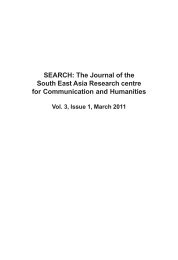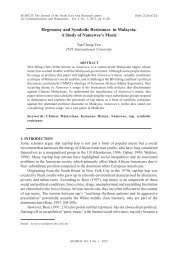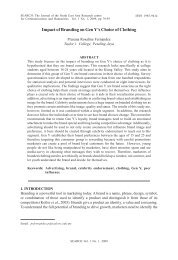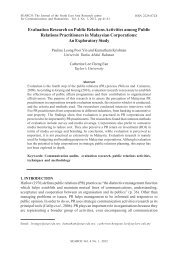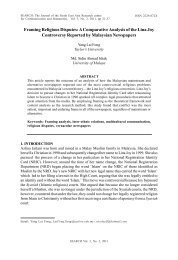Computer-Mediated Communication and Organisational ...
Computer-Mediated Communication and Organisational ...
Computer-Mediated Communication and Organisational ...
You also want an ePaper? Increase the reach of your titles
YUMPU automatically turns print PDFs into web optimized ePapers that Google loves.
<strong>Computer</strong>-<strong>Mediated</strong> <strong>Communication</strong> <strong>and</strong> <strong>Organisational</strong> <strong>Communication</strong> 3Some recent literature has moved a step further by emphasising the issue oforganisational communication as a networking tool <strong>and</strong> that collaboration is important forknowledge creation <strong>and</strong> transmission (More, 1998). People tend to get updated informationin a formal way. The management team will print out formal letters to all employees about thelatest changes <strong>and</strong> news of the organisation. However, in order to spread organisationalnews in a rapid <strong>and</strong> effective way, electronic communication technologies will be theirchoice of media selection. Maier <strong>and</strong> Warren (2000) assert that electronic communicationtechnologies provide both synchronous communications in which participants are in contactat the same time <strong>and</strong> asynchronous communications in which there is a significant delaybetween the transmission of a message <strong>and</strong> its reception.<strong>Computer</strong>, interactive video <strong>and</strong> other information technologies are very useful ininforming the employees about important internal messages as well as gathering their newideas (Wright, 1995). With the adoption of new communication technologies in organisations,the overall level of organisational communication has increased (Miller, 2009). Electroniccommunication technologies media used in the workplace includes telephone, fax, videoconferencing<strong>and</strong> Internet facilities such as email, Intranet <strong>and</strong> social media. Besideselectronic technologies, face-to-face communication is also used in workplace communication.Face-to-face communication is a conversation that one has while being face-to-face withthe other party. It can be started with formal <strong>and</strong> informal one-to-one meetings which wouldcomprise eye contact, facial expression, body movement <strong>and</strong> the tone of message that willshow the importance of the message. The way to interpret the message will largely dependon the differences in expression.2.2 <strong>Computer</strong>-mediated <strong>Communication</strong><strong>Communication</strong> media used to support the role of communication within organisationshave been <strong>and</strong> continue to be changed by the evolution of information technology withmuch of the communication now mediated by computers (D’Ambra et al., 1998). <strong>Computer</strong>mediatedcommunication (CMC) dates back to more than fifty years as it has been aroundsince the early 1960s. The rapidly-growing popularity <strong>and</strong> ubiquity of personal computershas caused CMC to become very attractive to scholarly communication (Thurlow et al.,2004). CMC is a form of human communication using computer <strong>and</strong> Internet network <strong>and</strong>this Internet-based communication takes place on a global collection of networks thatutilise the Transmission Control Protocol/Internet Protocol (TCP/IP) suite for data exchange(December, 1996). It is a type of communication which allows people to combine numerousmedia in a single message when conversing. CMC is an interactive channel which allowsusers to be active <strong>and</strong> engage in two-way communication. It is therefore an inexpensiveway of information-seeking for increased efficiency <strong>and</strong> productivity (Miller, 2009).The mediated nature of CMC allows greater manipulation <strong>and</strong> a more carefulconstruction of personal information; the delayed nature gives participants the opportunityto review, revise or cancel their communications before the information is sent (Heisler <strong>and</strong>Crabill, 2006). Besides, CMC is a form of asynchronous communication which has theadvantages of: (i) eliminating problems created by barriers of time <strong>and</strong> space; (ii) being costeffective<strong>and</strong> fairly easy to use; <strong>and</strong> (iii) has the potential of being more personal <strong>and</strong>SEARCH Vol. 3, 2011


